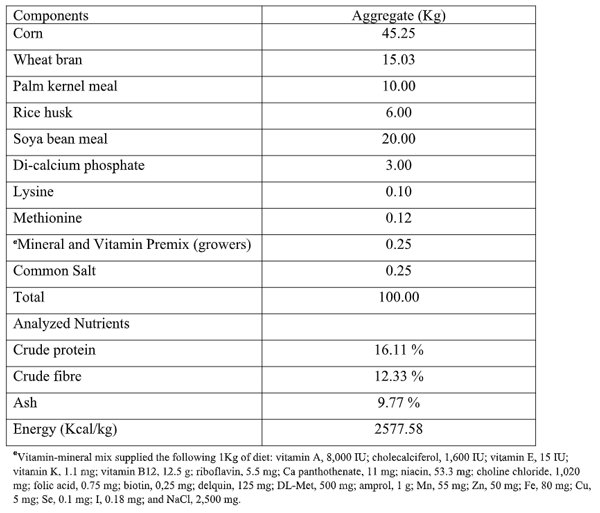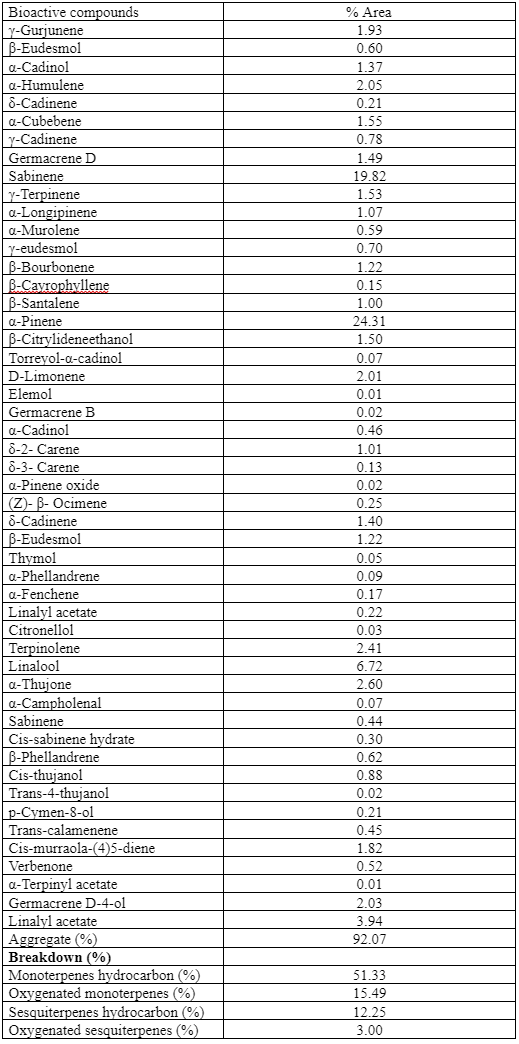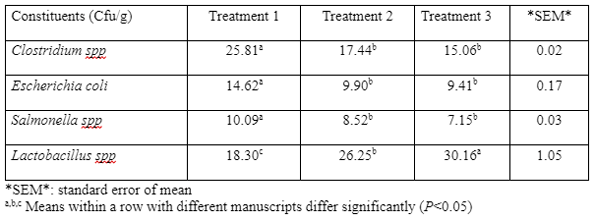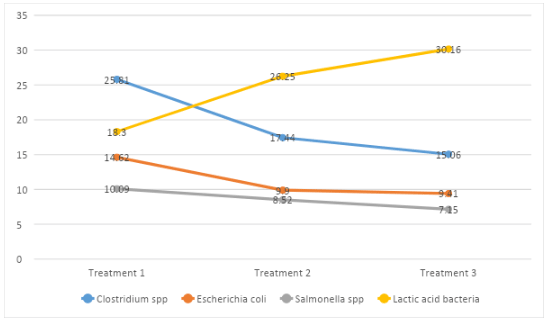Influence of Juniperus thurifera root extract on the nutrient digestibility and caecal microbial count of growing rabbits
Author details:
Juniperus thurifera root extract have an unending ability to synthesize secondary metabolites which plays vital role in the defense against pathogens and modulation of the immune system. This study was conducted to examine the Influence of Juniperus thurifera root extract on the nutrient digestibility and caecal microbial count of growing rabbits. Thirty – growing New Zealand white × Chinchilla male rabbits of 6-8 weeks of age weighing 605 ± 5.03 grams were used for the experiment. Rabbits were allocated into three treatments each with 10 animals. Each treatment consisted of 5 replicates with 2 rabbits per replicate in a completely randomized design. Rabbits in treatment 1 (control) was fed basal diet + 1.5 g oxytetracycline per liter of water while T2 and T3 were fed basal diet with 3 mL and 6mL of Juniperus thurifera root extract per litre of water respectively. Feed and water were provided ad libitum and the experiment lasted for 90 days. Results revealed a significant difference (P˂0.05) in dry matter, crude protein, crude fibre, crude fat, ash and nitrogen free extract values. Dry matter value were highest in T3, intermediate in T2 and lowest in T1 (P˂0.05). Caecal microbial count of Escherichia coli, Clostridium spp and Salmonella spp were higher in T1 compared to the other treatments (P˂0.05). Lactobacillus spp population were higher in T2, T3 and lowest in T1 (P˂0.05) thus promoting a healthy gut among rabbits fed Juniperus thurifera root extract. In conclusions, Juniperus thurifera root extract can be used as potential alternatives to antibiotics. It can also cause a reduction in animal disease which can have a negative effect on animal health, food supply and the economy.
Keywords: Juniperus thurifera, Phytochemicals, Microbes, Antibiotics, Performance, Nutrient.






Sexena, M.., Nema, R., Singh, D and Gupta, A. (2013). Photochemistry of medicinal plants. Journal of Pharmacognosy and Phytochemistry Centre of Microbiology and Biotechnology Research and Training Bhopal, India 8192 (1): 168-182.
Peréz, J.A and Aguilar, T.A. (2013). Chemistry of natural antioxidants and studies performed with different plants collected in Mexico. Available from: http://dx.doi.org/10.5772/52247 (Accessed May 2014).22.
Gülçin, I. (2012). Antioxidant activity of food constituents: an overview. Archives of Toxicology, 86: 345-39123.
Tsado N.A., Lawal B., Santali E.S., Mohammed, A.S., Balarabe, M., Mohammed,H and George, J.J. (2015). Phytochemicals and acute toxicity profile of aqueous and methanolic extracts of Crateva adansoniiLeaves in Swiss albino rats. Asian Journal of Biochemistry 10 (4): 173-179.24.
Asl, M.N and Hosseinzadeh, H. (2008). Review of pharmacological effects of Glycyrrhizasp. and its bioactive compounds. Phytochemical Research. 22: 709-724.
International Poultry Production (2004). Poultry Africa focuses on antimicrobial resistance challenge. International Poultry Production Magazine, 25(8): 13-14.
International Poultry Production (2009). Synergistic effect of bioactive herbal extracts in gut flora stabilization. . International Poultry Production Magazine, 30(2): 14-15.
International Poultry Production (2013). Full natural phytogenic support for intestinal resilience in poultry. International Poultry Production Magazine, 30(4): 25-26.
Muritala, Daniel Shittu., Alagbe, J.O., Ojebiyi, O.O., Ojediran, T.K and Rafiu, T.A. (2022). Growth performance and haematological and serum biochemical parameters of broiler chickens given varied concentrations of Polyalthia longifolia leaf extract in place of conventional antibiotics. Animal Science and Genetics 18(2): 57-71.
Alagbe John Olujimi, Ramalan Sadiq Muhammad., Shittu Muritala Daniel and Olagoke Olayemi Christiana (2022). Effect of Trichilia monadelpha stem bark extract on the fatty acid composition of rabbit’s thigh meat. Journal of Environmental Issues and Climate Change 1(1): 63-71.
Olafadehan, O.A., Oluwafemi, R.A and Alagbe, J.O. (2020). Carcass quality, nutrient retention and caeca microbial population of broiler chicks administered Rolfe (Daniellia oliveri) leaf extract as an antibiotic alternative. Journal of Drug Discovery. 14(33):146-154.
Alagbe, J.O., Shittu, M.D and Tanimomo, Babatunde K. (2022). Influence of Anogeissusleio carpus stem bark on the fatty acid composition in meat of broiler chickens. European Journal of Life Safety and Stability 14(22): 13-22.
Oluwafemi, R.A., Isiaka Olawale and Alagbe, J.O. (2020). Recent trends in the utilization of medicinal plants as growth promoters in poultry nutrition- A review. Research in: Agricultural and Veterinary Sciences. 4(1): 5-11.
International Poultry Production (2013). Effect of phytogenic feed additive on bird health. International Poultry Production Magazine, 22 (6): 7-9.
Alagbe, J.O(2022). Use of medicinal plants as a panacea to poultry production and food security: A review. Gospodarka I Innowacje 22(2022): 1-12.
Agubosi, O.C.P., Alexander, James and Alagbe, J.O. (2022). Influence of dietary inclusion of Sunflower (Helianthus annus) oil on growth performance and oxidative status of broiler chicks. Central Asian Journal of Medical and Natural Sciences 2(7): 187-195.
Agubosi, O.C.P., Soliu, M.B and Alagbe, J.O. (2022). Effect of dietary inclusion levels of Moringa oleifera oil on the growth performance and nutrient retention of broiler starter chicks. Central Asian Journal of Theoretical and Applied Sciences 3(3): 30-39.
Alagbe, J.O., Shittu, M.D., Ramalan, S.N., Tanimomo, K.B and Adekunle, D.A. (2022). Growth performance, semen quality characteristics and hormonal profile of male rabbit bucks fed Rubia cordifolia root extracts. International Journal of Biological Engineering and Agriculture 1(1): 1-13.
Agubosi, O.C.P., Imudia, Favour Dumkenechukwu and Alagbe, J.O. (2022). Evaluation of the nutritional value of air dried and sun-dried sweet potato (Ipomoea batatas) peels. European Journal of Life Safety and Stability 14(22): 43-51.
Alagbe, J.O. (2022). Prosopis africana (African mesquite) oil as an alternative to antibiotic feed additives on broiler chickens diets: haematology and serum biochemical indices. Central Asian Journal of Theoretical and Applied Sciences 3(2): 19-29.
Alagbe, J.O. (2022). Prosopis africana (African mesquite) oil as an alternative to antibiotic feed additives on broiler chickens diets: performance and nutrient retention. Discovery 58(314): 134 -142.
Alagbe, J.O and Ushie, F.T. (2022). Growth performance of broiler chicks fed diets containing different levels of aqueous Citrus aurantium stem bark extracts. Discovery 58(319): 735-741.
Alagbe, J.O., Shittu, M.D and Ushie, F.T. (2021). GC-MS analysis of methanolic stem bark extract of Zollingeriana indigofera. Asian Journal of Advances in Research 11(4): 144-146.
Alagbe, J.O (2021). Dietary Supplementation of Rauvolfia Vomitoria Root Extract as A Phytogenic Feed Additive in Growing Rabbit Diets: Growth Performance and Caecal Microbial Population. Concept in Dairy and Veterinary Sciences. 4(2):2021.
Adewale, A.O., Alagbe, J.O., Adeoye, Adekemi. O. (2021). Dietary Supplementation of Rauvolfia Vomitoria Root Extract as A Phytogenic Feed Additive in Growing Rabbit Diets: Haematology and serum biochemical indices. International Journal of Orange Technologies, 3(3): 1-12.
Singh, A.S., Alagbe, J.O., Sharma, S., Oluwafemi, R.A and Agubosi, O.C.P. (2021). Effect of dietary supplementation of melon (Citrallus linatus) seed oil on the growth performance and antioxidant status of growing rabbits. Journal of Multidimensional Research and Reviews, 2(1): 78-95.
Shittu, M.D., Alagbe, J.O., Adejumo, D.O., Ademola, S.G., Abiola, A.O., Samson, B.O and Ushie, F.T. (2021). Productive Performance, Caeca Microbial Population and Immune-Modulatory Activity of Broiler Chicks Fed Different Levels Sida Acuta Leaf Extract in Replacement of Antibiotics. Bioinformatics and Proteomics Open Access Journal 5(1): 000143.
Alagbe, J.O. (2021). Prosopis africana stem bark as an alternative to antibiotic feed additives in broiler chicks diets: Performance and Carcass characteristics. Journal of Multidimensional Research and Reviews, 2(1): 64-77.
Alagbe, J.O. (2021). Daniellia oliveri leaf extracts as an alternative to antibiotic feed additives in broiler chicken diets: Meat Quality and Fatty acid composition. Indonasian Journal of Innovation and Applied Sciences 1(3): 177-186.
Alagbe, J.O (2020).Chemical evaluation of proximate, vitamin and amino acid profile of leaf, stem bark and roots of Indigofera tinctoria. International Journal on Integrated Education. 3(10): 150-157.
Alagbe, J.O., Ajagbe, A.D., Attama Jeremiah, Philemon, K.C and Bello, Kamoru, A (2020). Albizia lebbeck stem bark aqueous extract as alternative to antibiotic feed additives in broiler chicks diets: Haematology, Serum indices and oxidative status. International Journal of Biological, Physical and Chemical Studies, 2(1): 8-15.
Alagbe, J.O (2020). Caecal Microbial Population of Growing Grass Cutters (Thyronoyms Swinderianus) Fed Phyllantus Amarus and Pilogstigma Thonngii Leaf Meal Mixture as Partial Replacement for Soya Bean Meal. Concept of Dairy and Veterinary Sciences. 3(5): 350 – 355.
Alagbe, J.O., Adeoye, Adekemi and Oluwatobi, O.A. (2020). Proximate and mineral analysis of Delonix regia leaves and roots.International Journal on Integrated Education. 3(10): 144-149.
Alagbe, J.O., Sharma, R., Eunice Abidemi Ojo, Shittu, M.D and Bello Kamoru Atanda (2020). Chemical evaluation of the proximate, minerals, vitamins and phytochemical analysis of Daniellia oliveri stem bark.International Journal of Biological, Physical and Chemical Studies, 2(1):16-22.
Farjon, A. (2013). Juniperus thurifera IUCN Red list of threatened species.e.T42255A2967372. http://dx.doi.org/10.2305/IUCN.UK.2013-1.RLTS.T42255A2967372.en
Adams, R.P. (2004). Junipers of the world. Trafford. ISBN 1- 4120-4205 – X
Farjon, A. (2005). Monograph of Cupressaceae and Sciadopitys. Royal Botanic Gardens, Kew. ISBN 1-84246-068-4.
Alagbe, J.O and Akintayo-Balogun, O.M (2020).Effects of dietary supplementation of Albizia lebbeck seed oil (ALO) on the fatty acid composition of weaner rabbits. Biochemistry and Biotechnology Research, 8(2): 29-33.
Musa, B.,Alagbe, J.O.,Adegbite Motunrade Betty, Omokore, E.A. (2020).Growth performance, caeca microbial population and immune response of broiler chicks fed aqueous extract of Balanites aegyptiaca and Alchornea cordifolia stem bark mixture. United Journal for Research and Technology, 2(2):13-21.
Shittu, M.Dand Alagbe, J.O. (2020). Phyto-nutritional profiles of broom weed (Sida acuta) leaf extract. International Journal of Integrated Education. 3(11): 119-124
Akintayo Balogun Omolere. MandAlagbe, J.O(2020). Probiotics and medicinal plants in poultry nutrition: A review. United International Journal for Research and Technology, 2(1): 7-13.
Alagbe, J.O. (2020). Effect of dietary supplementation of Cymbopogon Citratus oil on The Performance and Carcass characteristics of broiler chicks. European Journal of Biotechnology and Bioscience. 8(4): 39-45.
Omokore, E.O and Alagbe, J.O. (2019). Efficacy of dried Phyllantus amarus leaf meal as an herbal feed additive on the growth performance, haematology and serum biochemistry of growing rabbits. International Journal of Academic Research and Development. 4(3): 97-104.
Olafadehan, O.A., Oluwafemi, R.A and Alagbe, J.O. (2020). Performance, haemato-biochemical parameters of broiler chicks administered Rolfe (Daniellia oliveri) leaf extract as an antibiotic alternative. Advances in Research and Reviews, 2020, 1:4.
Agubosi, O.C.P., Oluwafemi, R.A and Alagbe, J.O. (2021). The effect of processing on the proximate, mineral and vitamin composition of Neem leaves (Azadirachta indica) grown in Gwagwalada, FCT, Abuja. Abuja Journal of Agriculture and Environment, 1(1): 293-299.
Alagbe, J.O. (2017). Nutrient evaluation of sweet orange (Citrus sinensis) fruit peel as a replacement for maize in the diets of weaner grass cutters. Scholarly Journal of Agricultural Science. 6(8):277-282.
Chris, K and Abel, S. (2008). Gut flora and immune modulation by plant extracts. International Pig Topics Magazine, 23(6): 9-11.
Zarei, A., Morovat, M., Chamani, M., Sadeghi, A.A and Dadvar, P. (2016): Effect of in ovo feeding and dietary feeding of Silybium marianum extract on performance, immunity and blood cation–anion balance of broiler chickens exposed to high temperatures. Iranian Journal of Applied Animal Science, 6: 697–705.
Pebriansyah, A., Lukešová, D., Knížková, P and Silberová, P. (2018). The Effect of Natural Phytoadditive Silybum marianum on Performance of Broiler Rabbits. Scientia Agriculturae Bohemica, 50 (1): 40–45.
Cross, D.E, McDevitt, R.M, Hillman, K, Acamovic T (2007): The effect of herbs and their associated essential oils on performance, dietary digestibility and gut microflora in chickens from 7 to 28 days of age. British Poultry Science, 48, 496–506. doi: 10.1080/00071660701463221.
Lahucky, R, Nuernberg, K, Kovac, L, Bucko, O, Nuernberg, G (2010): Assessment of the antioxidant potential of selected plant extracts – in vitro and in vivo experiments on pork. Meat Science, 85, 779–784. doi: 10.1016/j.meatsci.2010.04.004.
Lu, J, Idris, U, Harmon, B, Hofacre, C, Maurer, J.J, Lee, M.D (2003): Diversity and succession of the intestinal bacterial community of the maturing broiler chicken. Applied Environmental Microbiology, 69, 6816–6824. doi: 10.1128/ AEM.69.11.6816-6824.2003.
Maidment, D.C.J., Dembny, Z and Harding, C. (1999). A study on the antibiotics effect of garlic on E.coli and Staphyllococcus spp. Journal of Nutrition and Food Sciences, 4(5): 170-172.
Manzanillo, E.G., Baucells, F., Kamel, C., Morales, J., Perez, J.F and Gasa, J. (2001). Effects of plant extracts on the performance and lower gut microflora on early weaned piglets. Journal of Animal Science, 1, 473 (Abstract).
Ennajar, M., Bouajila, A and Lebhiro, A. (2010). The influence of organ, season and drying method on chemical composition and antioxidant activities of Juniperus phoenicea essential oils. Journal of Food Science and Agriculture, 90(3): 462-470.
Angoino, A., Barra, A., Russo, M.T and Cabras, P. (2003). Chemical composition of the essential oils of Juniperus from ripe and unripe berries and leaves and their antimicrobial activity. Journal of Food Chemistry, 51(10): 3073-3078.
Chouhan, S., Sharma, S and Guleria, S. (2017). Antimicrobial activity of some essential oils present status and future perspective medicines. Journal of Biochemistry, 4(58): 1-7.
Zeraib, A., Ramdani, M and Boudjedou, P., Chalard, P and Figuredo, G. (2014). Characterization and chemosystematics of Algerian thuriferous Juniper. Journal of Applied Biological Sciences, 87: 515-522.
Pothitirat, W., Chomnawang, M.T., Supabphol, W., Gritsanpan, W. (2009). Composition of bioactive compound content, free radical scavenging and anti-ache inducing bacteria activities of extracts from Mangosteen fruit rind at two stages of maturity. Fitoterapia, 80: 442 – 447.
Rezzi, S., Cavaleiro, A., Bighelli, L and Casanova, J. (2001). Intraspecific chemical variability of the leaf of essential oil of J. phoenicea from Corsica. Biochemical System and Ecology, 29(2): 179-188.
Szakiel, A., Paczkowski, C and Henry, M. (2010). Influence of environmental abiotic factors on the content of saponins in plants. Phytochemical Review, 10: 471-491.
Azzouzi, A., Zidane, L. (2015). La flore medicinale traditionnelle de la region de Beni Mellal. Journal of Applied Bioscience, 91: 8493-8502.
El-Alami, A., Farouk, L., Chait, A and Etude ethanobotanique sur les plantes medicinales spontances poussant dans le versant nord de l’Atlas d’ Azilal. Algerian Journal of Natural Products, 4(2): 271-282.
Adams, R.P. (2008). Junipers of the World: The genus Juniperus. Victoria, BC, Canada 2nd Ed. Trafford Publishing.
Tumova, E., Skrivavona, V., Zita, V., Fucikova, M. (2004). The effect of restriction on digestibility of nutrients, organ growth and blood picture in broiler rabbits. 8th World Rabbit Congress (1008-1014).
Placha, I., Chrastinova, L., Laukova, A, Cobanova, K., Takacova, J., Strompfova, V and Faix, S. (2013). Effect of thyme oil on small intestine integrity and gastrointestinal microbiota in rabbits. Acta Veterinaria Hungarica, 61(2): 197-208.
Chrastinova, L., Chrenkova, M, Laukova, A., Simonova, M., Szaboova, R., Chlebec, R. (2010). Influence of selected phytoadditives and probiotics on zootechnical performance, caecal parameters and meat quality of rabbits. Achrivan Zootechnia 13(2): 30-35.
Dazze Zotte, A., Sartori, A., Bohatir, P., Remighon, H and Ricci, R. (2013). Effect of dietary supplementation of spirulina and thyme vulgaris on growth performance, apparent digestibility and health status of dwarf rabbits. Livestock Science, 152: 182-191.
Alagbe, J.O. (2019). Role of Moringa olifera leaf meal on the growth performance of Poultry/African catfish – A review. International Journal of Advanced Biological and Biomedical Research. 7(3):249-257.
Alagbe, J.O. (2018). Effect of different levels of dried Delonix regia seed meal on the performance, haematology and serum biochemistry of growing Grass cutters. Agricultural Research and Technology Open Access Journal. 18(4):001-006







.jpg&w=3840&q=75)